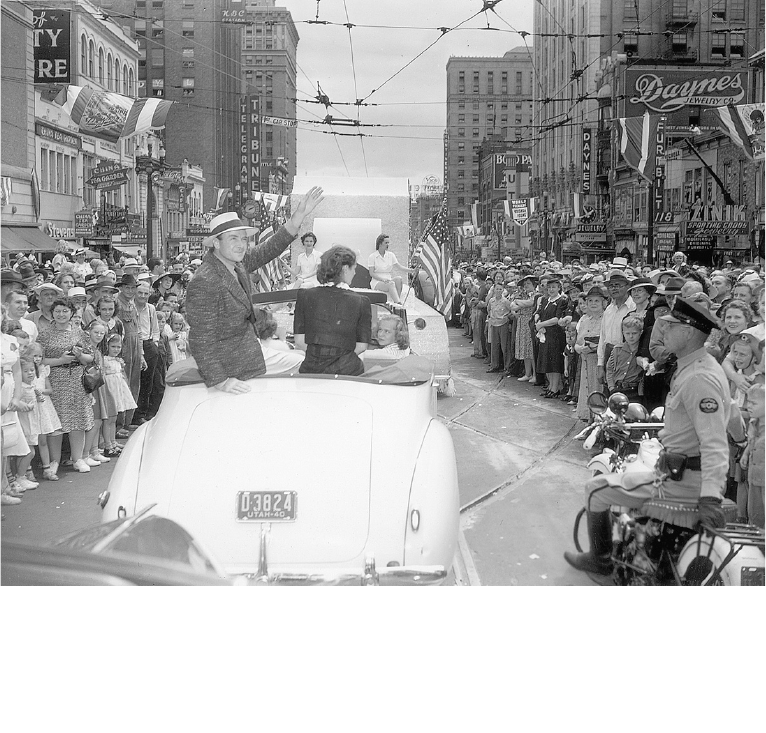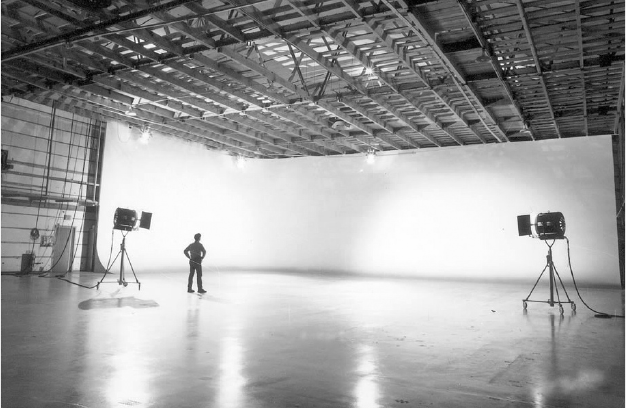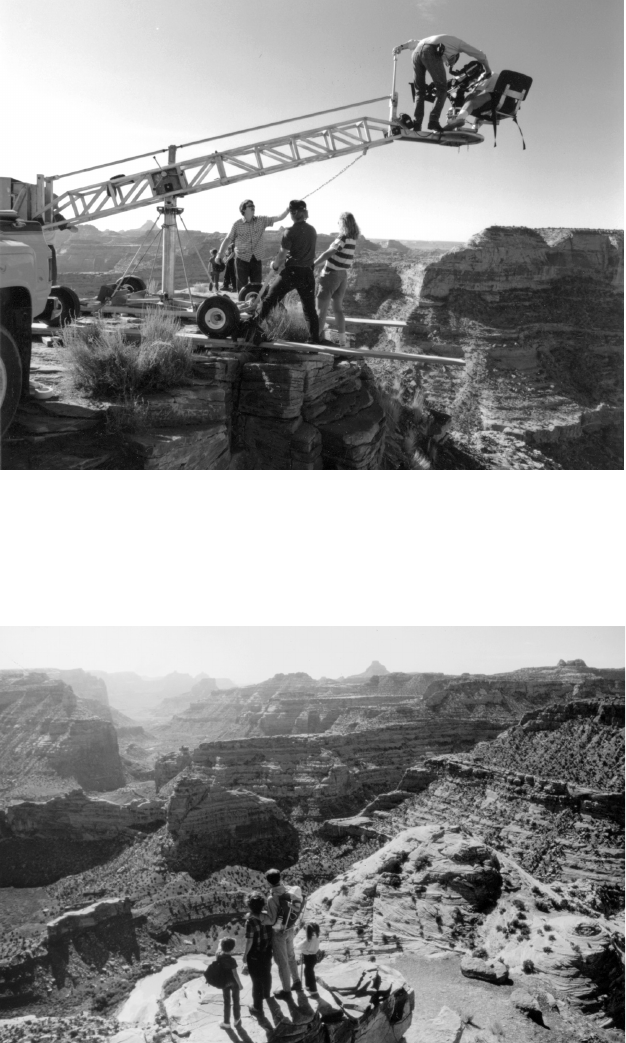
BYU Studies Quarterly BYU Studies Quarterly
Volume 46 Issue 2 Article 2
4-1-2007
A History of Mormon Cinema A History of Mormon Cinema
Randy Astle
Gideon O. Burton
Follow this and additional works at: https://scholarsarchive.byu.edu/byusq
Part of the Mormon Studies Commons, and the Religious Education Commons
Recommended Citation Recommended Citation
Astle, Randy and Burton, Gideon O. (2007) "A History of Mormon Cinema,"
BYU Studies Quarterly
: Vol. 46 :
Iss. 2 , Article 2.
Available at: https://scholarsarchive.byu.edu/byusq/vol46/iss2/2
This Article is brought to you for free and open access by the Journals at BYU ScholarsArchive. It has been
accepted for inclusion in BYU Studies Quarterly by an authorized editor of BYU ScholarsArchive. For more
information, please contact [email protected].

Salt Lake City’s rst and only “Brigham Young Day,” August , , celebrating the premiere
of Twentieth Century Fox’s Brigham Young. Dean Jagger, who proved a remarkable likeness to
Brigham Young, waves to a crowd of Latter-day Saints, who were enthusiastic that their second
prophet and the LDS faith were being depicted seriously in a nationally prominent motion picture.
Perry Special Collections, BYU.
1
Astle and Burton: A History of Mormon Cinema
Published by BYU ScholarsArchive, 2007

BYU Studies 6, no. 2 (27) 13
A History of Mormon Cinema
Randy Astle with Gideon O. Burton
O
n March , , Richard Dutcher’s lm God’s Army was released
in Utah-area theaters. It was a seemingly new entity: a feature lm
created by a Latter-day Saint, about Mormon life (missionary work), and
marketed primarily toward LDS audiences. At the time, the website of
Dutcher’s company, Zion Films, paraphrased a prophecy of Spencer W.
Kimball, famous among LDS lmmakers, of a future day “when our lms,
charged with the faith, heartbeats, and courage of our people would play
in every movie center and cover every part of the globe. . . . A day when
Mormon lmmakers, with the inspiration of heaven, would produce mas-
terpieces which will live forever.”
e website then condently armed,
“at day has come.” It described God’s Army as “the rst of many unique
and enduring Mormon lms,” stating that “such an endeavor has not
been attempted before” and “aer seeing this lm, you will ask yourself,
‘Why hasn’t anyone done this before?’”
With the commercial success of
God’s Army, the notion that it was indeed the “rst Mormon lm”—with
Dutcher himself “the father of Mormon cinema”—generally caught hold
with critics, the public, and even Dutcher’s competitors.
Even though Dutcher’s contributions were notably signicant, Mor-
mon movies actually began a century earlier, soon aer the beginning
of lm itself, and successive generations have reinvented, redened, and
repeatedly heralded the advent of Mormon lm. Sixty years before God’s
Army, Twentieth Century Fox premiered Brigham Young in Salt Lake City.
On that day, Friday, August , , shops, schools, and businesses closed;
both Governor Henry Blood and Mayor Ab Jenkins declared it a holiday
(“Brigham Young Day”); and the city’s population swelled from , to
,, with , people packing the streets to glimpse a gala parade
2
BYU Studies Quarterly, Vol. 46, Iss. 2 [2007], Art. 2
https://scholarsarchive.byu.edu/byusq/vol46/iss2/2

14 v BYU Studies
of the studio’s stars.
ere were shop window competitions and special
supplements in both the Salt Lake Tribune and Deseret News. President
Heber J. Grant held a banquet in the Lion House to honor the city’s distin-
guished guests, and that night, e Centre cinema—the city’s largest—sold
out at a pricey . per ticket, and thus six more theaters, totaling nearly
, seats, were lled for a simultaneous showing, making this world
premiere the largest in Hollywood history to that point. e crowds, seen
in newsreel footage, easily surpass those of any modern general confer-
ence or Sundance Film Festival, rivaling the foot trac of the Winter
Olympics. With President Grant’s public benediction on the lm—given a
few days earlier—fresh in their minds, surely the ecstatic Latter-day Saints
present would have thought themselves justied in declaring that Mormon
cinema had arrived.
Indeed, the cries of “Mormon cinema is born!” in echoed similar
proclamations from , , , and on back to .
In February of that
year, e Church of Jesus Christ of Latter-day Saints produced One Hundred
Years of Mormonism
in response to a spate of sensational Mormon-themed
lms that had been showing successfully in Europe and America.
A full een years later, in , when the Church announced the
production of its second historical lm (and the rst with an original
An empty soundstage at the LDS Motion Picture Studio. In its half century of
existence, the MPS has produced over one thousand lms. Courtesy Brigham
Young University.
3
Astle and Burton: A History of Mormon Cinema
Published by BYU ScholarsArchive, 2007
V 15A History of Mormon Cinema
musical score), All Faces West, it prompted the Detroit Michigan Free Press
to write, “At last the story of the Mormons is to be lmed!”
A month later
the Cleveland Ohio News conrmed that “the rst Mormon picture is
nished.”
Both newspapers were ignorant of previous Church-produced
and independent theatrical lms that had been alternately celebrating or
exploiting the Mormon story for years.
Movies and Mormonism took to each other quickly, but this is hardly
known in the absence of any comprehensive history of Mormon lm.
While I am not able to give an exhaustive history here, it is my intention to
give a more complete and coherent account than has previously been avail-
able in any single source; to bring to light largely unrecognized lms, lm-
makers, and movements (some artistically superior to their better-known
counterparts); and to provide an accurate contextual framework for the
production and reception of Mormon lms, past and present.
I oer this history as a starting point from which future critics,
lmmakers, and spectators may build. e necessary brevity of this his-
tory may open the way for more detailed discussions on specic lms,
people, eras, and movements. e ve historical periods or “waves” that I
have used to structure this history, while not denitive, are intended as a
framework within which past, contemporary, and even future lms may
be examined.
D S
Since God’s Army, “LDS cinema” or “Mormon cinema” has been the
label given to commercial feature lms that are marketed primarily to a
Latter-day Saint audience and that include an LDS director and Mormon-
themed subject matter. Such a narrow denition, however, proves inad-
equate for evaluating the full spectrum and impact of lms relating to
Mormonism and would exclude lms as diverse and important as Twentieth
Century Fox’s Brigham Young (), HBO’s Angels in America (), or
any of the hundreds of inuential institutional Church lms that have been
produced, whether Man’s Search for Happiness (), Johnny Lingo (),
or Legacy (). In this history, as is conventional in academic studies, I
have used “Latter-day Saint” or “LDS” to refer specically to the Church or
its members, while reserving “Mormon” to refer more broadly to the culture;
hence the preference for the term “Mormon cinema,” even though most
Latter-day Saints refer to the movement as “LDS cinema.”
My purpose is to survey the historical relationship between movies
and Mormonism generally, including the people, events, and cultural
4
BYU Studies Quarterly, Vol. 46, Iss. 2 [2007], Art. 2
https://scholarsarchive.byu.edu/byusq/vol46/iss2/2

A rather precarious crane shot during the production of the Church’s remake
of Man’s Search for Happiness (). Institutional LDS lms are a prominent
component of Mormon cinema, epitomizing Mormon movies for many. LDS
Church Archives, © Intellectual Reserve, Inc.
e scene resulting from the above crane shot for Man’s Search for Happiness. South-
ern Utah and Arizona deserts have been repeatedly used in lmmaking because of
their dramatic vistas. LDS Church Archives, © Intellectual Reserve, Inc.
5
Astle and Burton: A History of Mormon Cinema
Published by BYU ScholarsArchive, 2007
V 17A History of Mormon Cinema
forces both within the LDS faith and without that have shaped the evolu-
tion of Mormon lmmaking; the role of lm in Mormon life; and the way
Latter-day Saints have been depicted on lm by others. ese histories are
intertwined: mainstream Mormon-themed lms made outside of (and
oen in opposition to) the faith provoked institutional lmmaking; in
turn, the production and widespread use of lms by the Church and its
various institutions over the last century vindicated the medium and
trained and encouraged Latter-day Saints to develop the lm arts in new
and independent ways. Some LDS lmmakers, Dutcher in particular,
have reacted against institutional lms, creating movies that eschew the
idealistic characterizations and storylines so common in Church produc-
tions. Even those Latter-day Saints who never deal with Mormon sub-
jects but who have participated in the entertainment industry as actors,
technicians, and creative personnel t into the story, since Mormon lm
productions (institutional or private) have relied upon the talents of those
experienced in the mainstream industry. e emergence and increasing
robustness of Mormon cinema is in fact due to all of these factors, and not
just to the recent eorts of a few individuals or lms, however noteworthy
they have been.
Below I outline the ve periods or “waves” of Mormon cinema that
make up its history. Running through all of these periods are four distinct
subcurrents that help to further organize the chronological discussion.
Each is more or less prominent in a given period, but all occur in each of the
ve waves and together they constitute the larger eld of Mormon cinema:
. Depictions of Mormons in Mainstream Films
. Institutional (Church) Films
. Independent Mormon Films
. Latter-day Saints Working in the Mainstream Industry
Mormon literary scholars have taken a similar approach to these
four categories in their construction of the comprehensive Mormon Lit-
erature & Creative Arts database,
which in addition to literary works by
and about Mormons includes titles by non-Mormons important for their
depiction of Latter-day Saints (like the Sherlock Holmes novel A Study in
Scarlet—later adapted to lm) and mainstream work with no discernible
Mormon content authored by Latter-day Saints (such as Anne Perry’s Vic-
torian detective novels). It is my hope that a broad survey—including all
aspects of cinema as a social phenomenon—will help create connections
and continuity for the reader and expand the concept of what we can right-
fully consider the domain of Mormon cinema.
6
BYU Studies Quarterly, Vol. 46, Iss. 2 [2007], Art. 2
https://scholarsarchive.byu.edu/byusq/vol46/iss2/2
18 v BYU Studies
F W M C
e history of Mormon lm divides naturally into ve distinct chron-
ological periods beginning in and averaging twenty-four years each,
with God’s Army marking the beginning of the h.
Similar constructs
in the history of Mormon literature and some national cinemas name such
periods “generations,” but here I use the term “waves” for two reasons.
First, the brevity of the periods has allowed many individuals to work in
multiple eras, something not implied in a generational label. Second, a
“new wave”—a popular term in lm history—indicates not just a personnel
or chronological dierence but a fundamental artistic dierence between
the new and the old it is replacing. e most famous cinematic new waves
all materialized as conscious reactions against preceding norms, using
innovative stylistic techniques to emphasize their independence. Eventu-
ally these new modes are absorbed into mainstream practice, making way
for another wave to replace them.
Despite the danger of oversimplication inherent in such a straight-
forward model, I feel that introducing such a construct into the history of
Mormon lm can be immensely useful. It provides a convenient short-
hand, for instance, allowing for labels such as “a Fih Wave lm,” but,
more importantly, it reveals historical patterns present in each period. By
looking at the waves that have preceded it, we can expect the Fih Wave,
which since has entered something of a production slump, to gradu-
ally expand until a critical mass is reached and something new emerges,
resulting in the advent of a Sixth Wave in the s. Other critics are cer-
tainly encouraged to amend, challenge, or replace the ve-wave structure,
but it is my hope that from this point forward at least some model will be
in place to contextualize discussions of Mormon lm.
e First Wave (1905–1929):
e Clawson Brothers and the New Frontier
is period coincides roughly with cinema’s silent era (before the
introduction of synchronous soundtracks). Films in this period divide
fairly distinctly between sensationalist pictures aimed at exploiting Mor-
monism’s peculiar history and somewhat propagandistic lms made in
response to these by e Church of Jesus Christ of Latter-day Saints and
those sympathetic to it. Both types of pictures were shot on mm black-
and-white lm and were generally released to a paying public in commer-
cial cinemas.
7
Astle and Burton: A History of Mormon Cinema
Published by BYU ScholarsArchive, 2007
V 19A History of Mormon Cinema
e Second Wave (1929–1953): Home Cinema
is period has sometimes been considered a hiatus in LDS lmmak-
ing, though this is increasingly apparent as a misinterpretation. Pioneering
work in lmstrips, radio, and hitherto unheralded motion pictures was
laying the groundwork for all future institutional lmmaking. Depictions
from outside the Church were fewer but kinder in their representations.
On a technical level, both sound and cheaper mm lm stock were intro-
duced, with the occasional use of color. During this period the Church
nurtured a tremendous private lm distribution network that sidestepped
commercial theaters, not only allowing lmmakers to make works that
otherwise would not have existed, but creating a culture of cinematic
awareness among Latter-day Saints.
e ird Wave (1953–1974): Judge Whitaker and the Classical Era
e newly created BYU Motion Picture Studio started the production
of hundreds of Church lms, generally on mm lm stock, distributed
privately throughout the Church for multiple purposes and audiences.
Additional independent Mormon lms were attempted, and depictions
of Mormons in mainstream lms returned to showing them as objects of
curiosity as Hollywood standards relaxed.
e Fourth Wave (1974–2000): e Mass Media Era
e advent of video reduced costs and provided additional distribution
outlets, allowing many more Latter-day Saints to complete productions
within the marketplace and causing the total quantity of independent
works to increase dramatically. e Church also enlarged the scope of
its work by creating other production entities beyond BYU, oen shooting
on mm or even mm stock, and distributing its work through a variety
of channels including satellite broadcasts, television, VHS cassettes, and
destination cinemas at Church-owned visitors’ centers. Depictions of
Mormons in mainstream lm once again returned to sensationalist repre-
sentations, while large numbers of Latter-day Saints were working in the
entertainment industry.
e Fih Wave (2000–present): Cultural and Commercial Viability
Independent Mormon productions released on mm lm in com-
mercial theaters to a paying public have established a niche market within
American Mormonism. Video and DVD distribution of institutional and
independent Mormon lm are expanding, while Internet and digital lm
8
BYU Studies Quarterly, Vol. 46, Iss. 2 [2007], Art. 2
https://scholarsarchive.byu.edu/byusq/vol46/iss2/2
20 v BYU Studies
suggest new formats and modes of distribution. An LDS Film Festival
now coincides annually with the Sundance Film Festival. Institutional,
independent, and mainstream treatments of Mormon themes, while still
distinct, have begun treating Mormonism with more complexity. Latter-
day Saints are starting to sense the emergence and importance of their
own lm tradition, suggesting the beginning of a culturally identiable
(but institutionally independent) Mormon cinema.
T H S
e advent of movies in the s coincided with important cultural
changes within e Church of Jesus Christ of Latter-day Saints that
indicated a shi from pioneer isolation to twentieth-century integration.
e Manifesto ending polygamy came in , and the Salt Lake Temple
was dedicated in , ending forty years of construction and concretely
symbolizing the end of the pioneer period. e temple’s interior murals
were completed by artists who had been sent, as missionaries, to the Aca-
démie Julian in Paris where they became trained in modern styles such
as Impressionism and Expressionism. e murals thus had much more
in common with the French avant-garde than with the stark images of
previous Mormon painters. Additionally, the Church dissolved the local
People’s Party, encouraging members to aliate with national political
parties; it also closed down most of its private academies to accommodate
the previously distrusted public schools and sold o most of its businesses.
Such conciliatory eorts were rewarded when Utah gained its long-awaited
statehood on January , . Similarly, by the s Church leaders cau-
tiously ceased admonishing converts to move to Utah, essentially marking
the end of the gathering period. In short, the focus of the Church began to
shi from inward isolation to outward accommodation. e Church was
now ready to engage the world.
It is particularly tting that the Church’s rst recorded brush with
lm came in , in a situation consciously designed to demonstrate
Latter-day Saints’ similarity to other Americans. e Spanish-American
War was America’s rst conict aer Utah’s admission to the union, and
the majority of LDS Utahns viewed it as an opportunity to display their
patriotism. Hence, when Colonel Jay L. Torrey secured legislation to form
three companies of elite cavalry—the Rough Riders—Utahns reacted with
enthusiasm, with many enlisting in Torrey’s own regiment, known as the
Rocky Mountain Riders. John Q. Cannon—son of George Q. Cannon, First
Counselor in the First Presidency—became captain of the Utah Company,
9
Astle and Burton: A History of Mormon Cinema
Published by BYU ScholarsArchive, 2007
V 21A History of Mormon Cinema
which consisted of eighty-six men, mostly LDS. e group was mustered
into service on May , , at Fort Russell, Wyoming, and traveled by
rail to Jacksonville, Florida, where they remained throughout the sum-
mer. us they missed the famous charge up San Juan Hill but were on
hand in July to be lmed by the American Mutoscope Company. Among
many other titles lmed of the troops is one entitled Salt Lake City Com-
pany of Rocky Mountain Riders, a lengthy -foot piece (approximately
two and a half minutes) probably released immediately. While the Utah
Company was disappointed not to engage the Spanish, Cannon and his
men apparently did become the rst Latter-day Saints—or Utahns, for that
matter—to be lmed.
Less is known about when Latter-day Saints, in Utah or elsewhere, rst
viewed moving pictures. Early on, “editorials in Utah as elsewhere echoed
the concern, particularly of churchmen, that the unparalleled impact of the
moving picture image would harmfully inuence susceptible minds.”
It
would not be long, however, before exhibition venues proliferated in the
state, and by the close of cinema’s rst decade Mormon communities such
as Salt Lake City reportedly had exhibition facilities comparable to any city
in the nation. e Mormons were ready for the movies.
10
BYU Studies Quarterly, Vol. 46, Iss. 2 [2007], Art. 2
https://scholarsarchive.byu.edu/byusq/vol46/iss2/2
